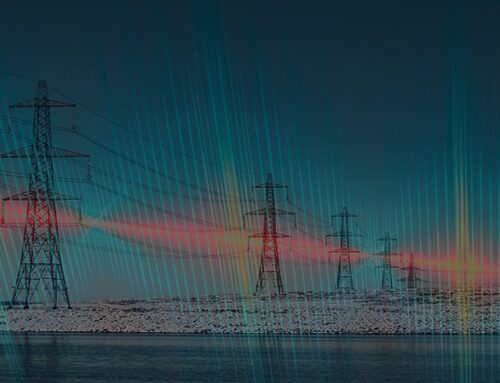On Friday evening, there was a widespread power blackout across many parts of the UK, with transport systems in particular being affected. Supplies were restored within an hour although the transport problems took far longer to resolve, with the knock-on effects of delayed trains and trains and passengers being stranded at different points on the network.
Around 500,000 customers in Wales, the south-west England and the Midlands were affected, along with 300,000 customers in south-east England, 110,000 in Yorkshire and north-east England and 26,000 in the north-west England, according to the distribution network operators in those areas.
Of course, questions are being asked about why and how this blackout happened, with some commentators such as Lord Adonis, the former Chairman of the National Infrastructure Committee, saying that two such occurrences in 11 years is a major failure on the part of National Grid, and utterly unacceptable.
So why did the outage happen, and is it a sign of poor management of the electricity system, a symptom of the changes taking place on the electricity network, or simple bad luck?
Causes of the blackout
The full causes of the blackout are not yet known. What is known is that at 16:57, the 727 MW CCGT at Little Barford in Cambridgeshire shut down, followed at 17:00 by units 2 and 3 of the windfarm at Hornsea, 120km off the Yorkshire coast, each with a nominal capacity of 406 MW. RWE said Little Barford shut down in line with normal practice when demand reached 23 GW.

The sudden removal of 1.5 GW of generation from the system caused a sudden drop in system frequency, to below 49 Hz, far outside the normal system tolerance of 50 Hz ±1%, meaning that automatic system protection protocols were triggered. These protocols involve rapid load-shedding in order to stabilise system frequency to avoid a cascading failure affecting the entire power grid. The process is automated.

National Grid told Bloomberg that the power failure amounted to an “unexpected and unusual event”:
“The system operated as planned by disconnecting an isolated portion of electricity demand,”
– National Grid

The UK’s large pumped storage facilities at Dinorwig and Festiniog immediately came online, followed by a rapid ramping up of other CCGTs. Interestingly, despite the day seeing higher wind generation, a coal unit ran for most of the day. Also, the bulk of the wind came from onshore sources.

Was this bad luck or bad planning?
Energy consultancy EnAppSys suggested that the system should have been able to cope with the loss of this amount of generation, and that there may have been other issues in play at the time of the trips. Indeed, from BM Reports it is clear that there were also problems at the huge Drax power station in Yorkshire thoughout the day.

It is also the case that there was an unusually large amount of wind generation on the system that day, with National Grid having tweeted earlier in the day that a record 67% of electricity demand was being met by wind. Having a high proportion of wind on the system presents two challenges to system stability:
- Wind is intermittent, so the output is constantly varying with time creating continuous changes in the supply and demand balance, and consequently in system frequency, that must be managed;
- Unlike thermal generators, wind power does not provide any inertia to the electricity grid, so when wind power displaces thermal generation, the amount of available inertia is significantly reduced. Inertia acts to dampen changes in system frequency, so not only does a higher proportion of wind on the system increase the levels of frequency change, it also reduces the natural mechanism by which changes in frequency are contained.
Some industry participants have argued that Friday’s events illustrate the need for more flexible generation and storage on the grid, to counteract these effects:
We thought we would be waiting for a cold winter for the impact of intermittent renewables to strike – however unwelcome, this is just another milestone in the energy transition from fossil fuels to renewables. It demonstrates with great clarity the urgent need for electricity storage at scale on the UK’s grid,”
– Mark Simon, chief executive at battery storage firm Eelpower
However, a single event does not constitute a trend, and wind has been contributing an increasing amount to the power grid for some time without incident. The last time the country saw a similar blackout was in May 2008, when wind penetration was much lower. In that instance, the now-closed Longannet coal-fired power station in Scotland went offline, followed 2 minutes later by the Sizewell B nuclear power station in Suffolk.
This resulted in a sudden loss of 1,510 MW of generation meaning the system experienced a sudden drop in frequency and emergency protection measures triggered load shedding. In addition, other power stations, including a significant volume of embedded generation, reacted to the drop in frequency by disconnecting themselves (also automatic protection measures). Some 500,000 people were affected.
It is rare for two large power stations to trip in such quick succession, so the question is whether the investment needed to create resilience in the face of such infrequent occurrences would justify the cost. Some people, such as Lord Adonis, believe these two events constitute a major failure by National Grid, and that the system operator had failed to learn the lessons of the previous event, but it is entirely reasonable to question whether the cost of maintaining supplies for a once-in-a-decade event would be justified.
It is also somewhat self-serving for providers of battery storage to point to this incident as illustrative of the need for more storage without clear evidence that Friday’s outages were directly the result of the impact of renewable generation on the grid, which so far does not appear to be the case.
In this latest large-scale blackout just under a million people were affected, but within 15 minutes DNOs were able to begin restoring demand, and all users were re-connected within 45 minutes. What made the incident more disruptive was the fact the transport infrastructure was impacted by the automatic load shedding, and took far longer to return to normal service. National Grid has said it will review its system protection measures, and should look in particular at which loads were disconnected and why to determine whether targeting other sources of demand would have resulted in lower disruption to the public.
Paying for a lower carbon elelctricity system
Over the next few weeks, more information about Friday’s blackout should emerge. In addition to understanding whether the protection systems operated appropriately, the reasons for the outages at Little Barford and Hornsea should become clearer, and in particular why the former suddenly went offline in response to lower system demand, and whether the latter tripped as a result of Little Barford going offline, whether there was a problem relating to high winds, or whether it was an un-related mechanical issue.
From the limited information available so far, it seems most likely that Friday’s events were simply bad luck, and sufficiently rare that the costs of preventing them would outweigh the benefits. However questions do need to be asked in relation to the impact on the transport infrastructure, and organisations across the country should review their own responses to the incident – for example why a back-up system at Ipswich hospital failed (fortunately not one affecting critical care).
One thing that is certain is that this major blackout is a useful reminder that maintaining security of supply is not a trivial problem at the best of times. De-carbonisation is changing the fundamental operation of the electricity system, and makes balancing supply and demand, and maintaining system frequency far more challenging.
Rising network costs are one of the drivers of higher electricity bills, but the fact that it has been more than a decade since the last major power outage indicates that these costs are in fact delivering a high level of reliability. It is the job of Ofgem, through the RIIO process, to ensure that these costs are reasonable and that this reliability is being delivered efficiently.






The 67% figure for wind power might give some people a warm feeling, but to me it is worrying that the grid is allowed to operate with such a high figure. The Irish had a 50% limit, but are raising it gradually. Wind power fluctuations, and unpredictability must rise when it gets more windy. No doubt the power outages will be blamed on one or two specific causes, but will the underlying grid instability get a proper mention?
I agree, although the timing of the tweet suggests the 67% was in the middle of the night, which would be less risky. My sense is that this specific incident was not to do with the generation mix being wind-heavy at the time, but that’s not to say the situation isn’t risky. I thought it was very interesting that a coal unit was running for most of Friday – possibly because of the issues at Drax and the fact it’s the annual nuclear maintenance season. Still, whatever the hype about moving towards 100% renewables and net zero carbon, running coal in the summer would suggest we’re much further from that than the 67% figure would imply.
Ireland’s current limit on instantaneous penetration of asynchronous resources 65%, not 50%, and they’ve been operating in that mode without incident for some time now.
[…] On 12th August (UK time) this article “What caused the UK’s power blackout and will it happen again?” was publi… that explains some things in more detail than I was able to […]
Thanks Kathryn
Some more information, compared to what I was able to do from afar here:
http://www.wattclarity.com.au/articles/2019/08/initial-thoughts-and-questions-about-last-fridays-under-frequency-load-shedding-in-great-britain/
Paul
Hi Paul,
That’s a great analysis. One thing that will be interesting to see when NG reports on this fully is the exact timing of the trips and the frequency dips. The frequency chart in your post is GMT, so an hour behind BST as you suggest, but the first dip appears to be slightly before Little Barford went offline. Different sources have slightly different times…I used the REMIT data, but I’m not sure whether there is a real time difference or whether it’s down to the sampling.
Here is some wider information on the frequency response tools available to National Grid: https://www.nationalgrideso.com/balancing-services/frequency-response-services
Kathryn
Typo alert
system frequency chart is wrongly dated 19th
Also
” National Grid having tweeted earlier in the day that a record 67% of electricity demand was being met by wind”
No; in the tweet, they claimed 67% Zero carbon….
wind was 41%:
Amazingly Solar was 8% ( at 2.40 AM ??? [ must have been a full moon ] )
Sorry to be pedantic …
…no I’m not (:-))
Thanks for pointing out the typo…I’ve fixed it.
Good point about that tweet…their later “wind-o’clock” tweet about wind being close to 50% was on my mind. There was a fair bit of run-of-river hydro running through the day. It wasn’t a full moon though…next one is due on the 15th! There must be some issue with the timing of the tweet because there wasn’t any solar running at 2:40am according to BM reports.
Pedants rule!
Kathryn,
Some thoughts:
a) Planned closure of coal units / stations can result in some coal units running “out of the money” as they run down coal stocks.
b) That said, National Grid will sometimes pay to run coal units in the summer for system stability reasons (see below).
c) Summer, overnight low load condition is not necessarily less risky. In fact, it can be more risky as the proportion of the largest generator to overall system generation becomes bigger. Also high wind generation under low load conditions means there is proportionally less system inertia combined with fewer units available to provide frequency response (the nuclear units generally can’t).
I agree – particularly on (b), which links to my previous comment about us not yet being in a position to manage without coal, despite the renewables hype. In the winter the % coal can be as high as 20%.
My point about overnight being less risky related to the impact on consumers – had Friday’s outage taken place in the middle of the night, the impact would have been much lower and there would be a lot less noise about it. I agree that system stability would be lower with high % wind overnight, and on the 9th the coal unit only ran during the day, although I’d have to look into the numbers again to see whether thermal had a lower contribution overall that night or not.
Hi, Kathryn,
I enjoy your blogs (the ones I understand) especially reading this one.
I have a quick question if your able to answer, regarding the outage.
Be gentle, I’m an electronics engineer, not a power engineer.
Are you saying that after the initial 2 generators went off line, the then reduction in load caused by the load shedding, caused Little Barford and Hornsea to shut down assuming they were not required?
Or was it the lower frequency, I would assume that after shedding the load the frequency would return to normal?
Simon
Hi Simon,
Thanks for reading my blog!
From what NG has said, two large power stations went offline in quick succession, which caused a sharp and sudden drop in system frequency which triggered protection measures. These measures included load shedding to restore the frequency to acceptable levels and to prevent uncontrolled effects that might see other generators go offline.
Frequency falls if demand exceeds supply. If two power stations suddenly disconnect, supply will be suddenly lower than demand and the frequency will fall.
However there are a couple of things that puzzle me…according to the REMIT data (times in GMT), Little Barford went offline first, at 15:57:40, followed at 16:00:00 by Units 2 and 3 at Hornsea. This does not line up with the frequency data which shows it dropping at 15:53:00. It is also interesting to note that while RWE issued its REMIT notice a couple of minutes before Little Barford went offline, the Hornsea REMIT notices were only published at 16:19:48 for Unit 2 and 16:26:11 for Unit 3 – significantly after they went offline. This is a very big delay in the circumstances, and it would be interesting to know why.
I suspect that the Hornsea trip actually came first, between 15:52:30 and 15:52:45 where the sudden drop in frequency is seen on the chart. The reasons for the trip are still under investigation according to the REMIT notices.
Then we have Little Barford. RWE is reported as saying it came off as demand fell to 23 GW, but I’m not sure this really makes sense. Its REMIT report cites “turbine generator” as the cause of the outage, suggesting a mechanical fault, and it didn’t start to ramp back up until 20:00:00
The frequency was back up within normal tolerances by 15:55:00, 37 seconds before RWE issued its REMIT notice that Little Barford was going offline, which all casts some doubt on National Grid’s explanation of events. It will be very interesting to read the final report on this, and whether the REMIT notices for Hornsea are revised (and whether Orsted, the operator of Hornsea is penalised for its late and potentially inaccurate REMIT publications).
If Hornsea did come off first, the question is why, and whether it was to do with high wind speeds at the time. Then did Little Barford come off as a result of the frequency drop, or was it responding to earlier market conditions (the fall in demand) or was it an un-related mechanical failure?
Apologies for the long-winded reply (pun intended!) – I’ve been thinking more about the timings and they’re just too wide to be down to sampling differences. If the frequency data are correct then there must be something wrong with the REMIT notices, and the Hornsea ones, being published so long after the fact are the more doubtful ones.
Kathryn
Mornin’ Kathryn……..again my reply comment of yesterday has failed to be displayed; any ideas ?…….regards….. Barry Wright
[…] climate to trigger blackouts. In August 2019, giant elements of southern England noticed their power cut off throughout a interval when a document 67 % of electrical energy demand was being met by wind. A […]